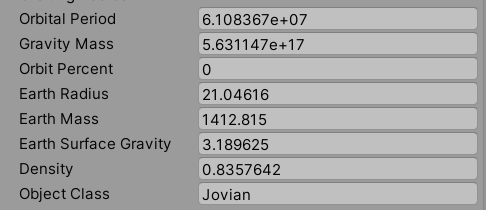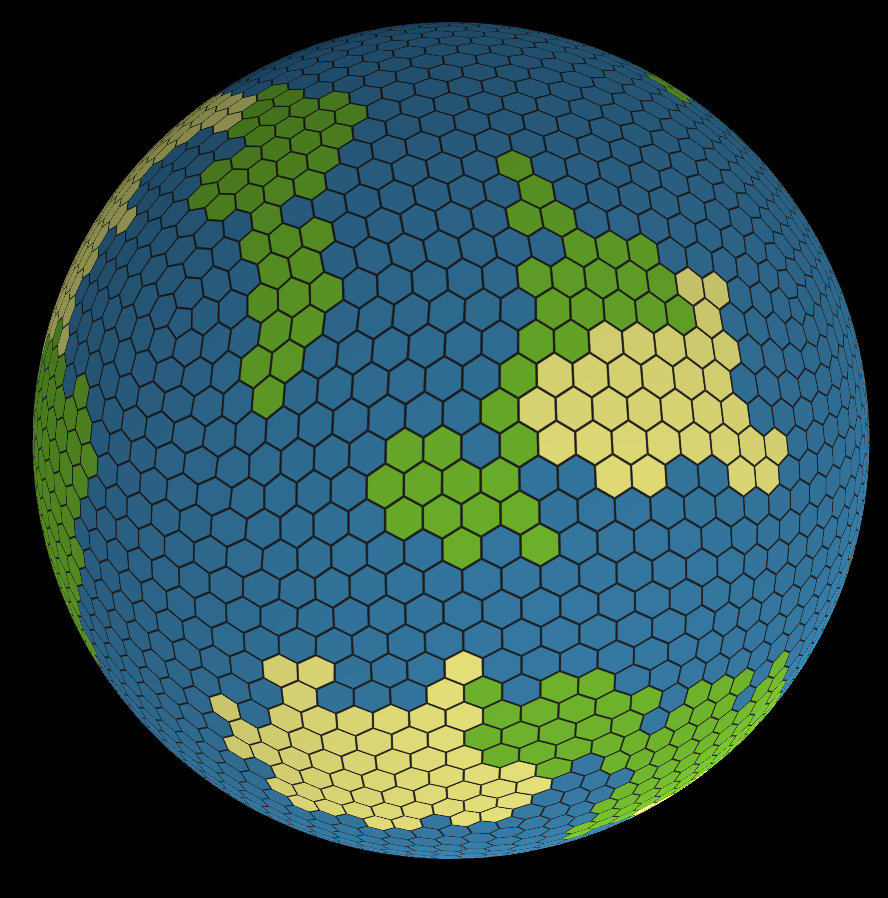Weekly Update 4 - (10/25/2020)
That's right, it's update time
Hey everyone, Andrew here, about to tell you what we've been working on this week.
Planet Properties Generation
I've been spending most of my time this week tweaking and experimenting with the properties that celestial bodies will generate with, primarily mass and radius. We are seperating these bodies into two main categories, terrestrial (like the Earth), and Jovian (like, well, Jupiter). Planets will have different generation equations based on their category.
Of course, it takes a bit of work to make sure these equations play well. We have mass distribution equations that follow observed data, but I'm working to ensure that the bodies generated that follow these masses can plausibly exist. As in, terrestrial planets don't spawn in larger than Jupiter, and Jovian planets don't spawn in that have a mean density higher than Earth (did you know that the Earth is the densest planet in the Solar System?).

Chunky planet (But one that definitely could exist)
Along with these planets I've also been working on plausible moon generation, which follows a similar process. I'll be continuing work on generation throughout the next work.
Steam
We're just about ready to submit our Steam page for review! Even after we're done, it will take some time for the game to be available - it looks like the review process takes a week or so, and then the Steam page has to be up for two weeks before the game can actually be bought and downloaded. We'll let you all know when the Steam page is up and running.
We had a really exciting development this week (well I'm excited about it anyways). I asked Bryon to write the below section about our journey:
MakeIt.Tile or: How I Learned to Stop Worrying and Love the Grid
Over the past few months, I have attempted to develop solutions for hex-based grids for representing celestial bodies and their surfaces. Each attempt has been more strange than the last. Early implementations were atrocious vector math monsters, I clearly had no clue what I was doing. But after a couple months and some more research it became clear to me that geometry held all the answers right in front of me.
Conway notation, geodesic polyhedra, class I Goldberg polyhedron, these might not mean much to you, but they have been a source of great pain for me in the past weeks. Turns out making a spherical hex grid is a RELATIVELY simple matter. It involves an icosahedron, a lot of subdivision, and the use of a dual operation. Sounds simple enough, however doing this yourself when you are only just learning how to generate meshes in Unity is not particularly an easy task. And the developing a method by which to be able to index between these hexes, access each polygon and apply a texture uniformly, NO SIMPLE MATTER.
After much deliberation and consternation, I came across the most wonderful of projects. Yah boi, Andy Gainey, back in 2015 developed a framework for handling grids in unity and made his project publicly available under the title MakeIt.Tile. It is not a complete solution, but rather a framework upon which you can develop your own implementations as you need them. Most interesting and useful for Glorious Dawn is of course his solution for spherical hex grids.
By incorporating this most blessed project into Glorious Dawn we can ensure the efficacy and efficiency of our spherical hex-grid implementation. Given that the grids created can be seeded and thus can be deterministic, saving an entire planet in a save file can be as simple as saving that planets seed value and whatever has been changed since the game began. The framework is setup with a plethora of useful methods and object classes allowing us to tailor the framework to our needs. Indexing between tiles and searching neighboring tiles is a simple task, where it once had me pulling my hair out. Truly, Andy Gainey and his MakeIt.Tile is a god send.
The worlds we can create using this framework are going to be amazing.




A lot of work is still left to do before we are anywhere near releasing Kepler, but with the help of MakeIt.Tile our path to launch has just become oh so much more clear.
This is going to be very useful. Alright, that's it for these week. See you all next Sunday!
Get Glorious Dawn
Glorious Dawn
Space Opera Simulator
| Status | In development |
| Publisher | |
| Author | Big Owl Interactive |
| Genre | Simulation |
| Tags | 4X, Exploration, grand-strategy, Immersive, Real time strategy, Sci-fi, Space, Space Sim, Unity |
| Languages | English |
More posts
- Weekly Update 13 - (02/01/2021)Feb 02, 2021
- Weekly Update 12 - (1/12/2021)Jan 12, 2021
- Weekly Update 11 - (12/27/2020)Dec 28, 2020
- Weekly Update 10 - (12/21/2020)Dec 22, 2020
- Weekly Update 9 - (12/7/2020)Dec 08, 2020
- Weekly Update 8 - (11/22/2020)Nov 23, 2020
- Weekly Update 7 - (11/15/2020)Nov 16, 2020
- Weekly Update 6 - (11/8/2020)Nov 09, 2020
- Weekly Update 5 - (11/1/2020)Nov 02, 2020

Leave a comment
Log in with itch.io to leave a comment.